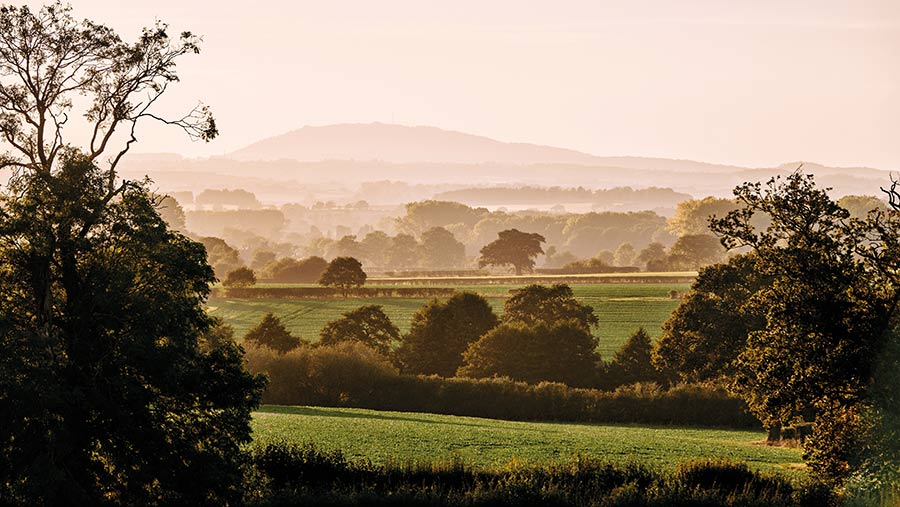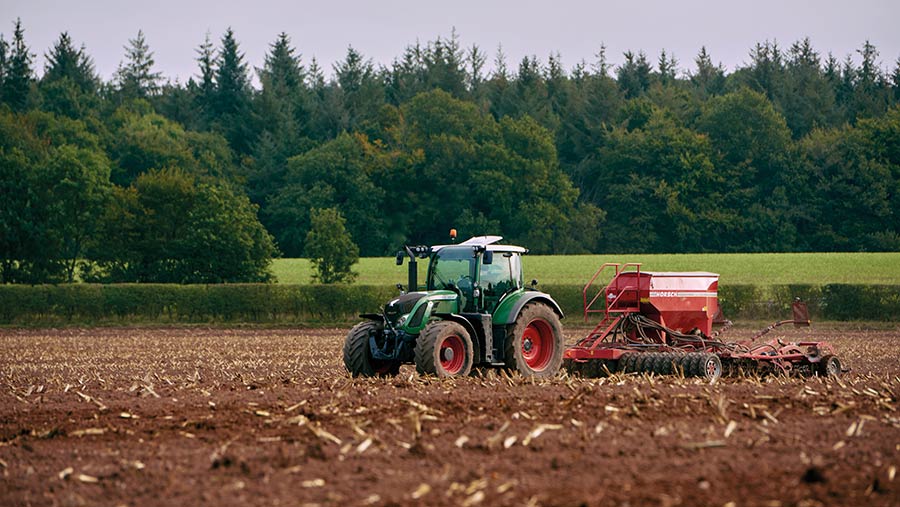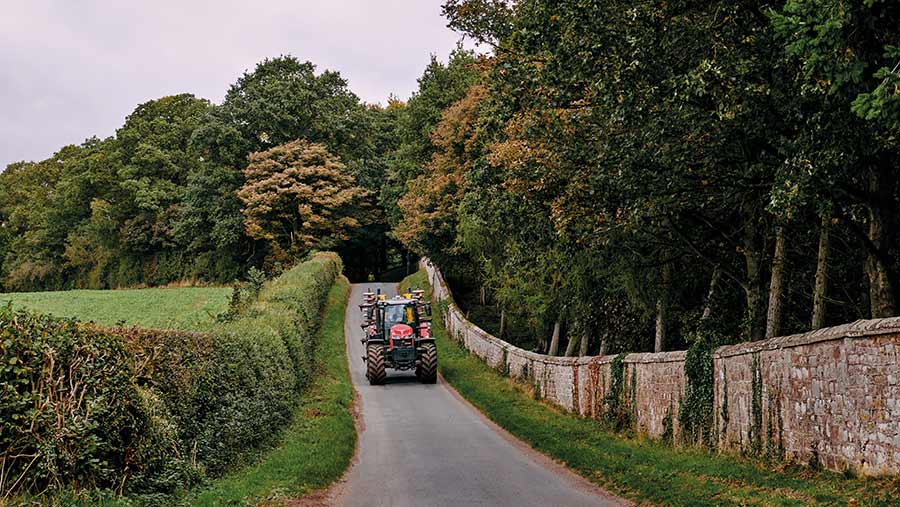How West Midlands farm is planning regen approach on 1,600ha
 © Bradford Estate
© Bradford Estate It’s unusual to become farm manager without any actual land to farm. But that’s exactly the situation Oliver Scott walked into when joining Bradford Estates in February 2021.
At that point the 4,800ha estate’s farming operation was carried out entirely under various Agriculture Holding Act (AHA), Farm Business Tenancies (FBT) or contract farming arrangements.
The estate, which stretches across parts of Shropshire and Staffordshire, was seeking to bring back more control under managing director Alexander Newport’s direction.
See also: Are no-till potatoes a pipe-dream?
“This will help diversify the estate away from just investment property into more operating businesses, giving us more resilience and diversity,” explains Mr Newport.
That led to Mr Scott’s appointment, and 1,600ha being taken back in hand on the estate, mostly from two different management regimes, with further land expected to be added in the future.
“I turned up with a blank piece of paper – with no team, no machinery, and no land until August,” Mr Scott says. “So I spent the first six months getting to know the estates and writing a farm business plan about how the new farming business would look over the next five years.”

Oliver Scott © Bradford Estate
One clear direction of Mr Scott’s was to take a more regenerative approach. The business plan aims to use 15-20% fewer inputs over the next five years, with an allowance of 5-8% decrease in yield while the system beds in.
At time of writing the business plan, that would have increased margins over a more intensive maximum yield approach, he says.
“Going from a system that is averaging 8.6t/ha for winter wheat in a high-input, high-output system, reducing inputs by 20%, and then if we can average 7.5-8.0 t/ha, the margin would be better.
“Obviously the current commodity prices have distorted that, but they haven’t changed our view that we should become regenerative farmers.
“We can’t let the market dictate too much what we are trying to achieve. The market might be like this for the next three years, but the longevity of what we are trying to achieve is for the next 20 years.”
Taking time
Implementing the plan is going to take time on the two contract farming operations taken back in hand, he stresses. “The two farms are like chalk and cheese.”
One was geared up around high value crops, with potentially two or three root crops in a five-year rotation with some occasional chicken muck applications, plus solid and liquid digestate, while the other grew high value crops on a smaller scale, had straw for muck deals, and used more minimum cultivations.
“My brief is to look at the regenerative model, but we’re very much taking conventional farms into that system.”
A starting point has been to zone the farms into distinct areas for detailed soil analysis by Sustainable Soil Management through Hutchinson’s agronomist Ed Brown. The survey will give a baseline for the condition of the soil, including chemistry, physics and biology.
One immediate benefit of the soil survey is to inform decision-making around cropping and the rotation, and how quickly he can transition to a more sustainable approach. “It’s going to take time to get the rotation right, and for it to work as a whole farm and not two half-farms.”

© Bradford Estate
Longer rotation
The present plan is to lengthen to a nine-year rotation, which will include one year each of potatoes and lettuce, with the rest in combinable crops including cereals, spring beans and maize, plus grass and lucerne. Cover crops are being grown before any spring crop in the rotation, which are destroyed through some combination of grazing, topping and glyphosate.
He recognises some might question whether a rotation with potatoes and lettuce can truly be described as regenerative with the soil movement typical for these crops. But with the soil type suitable for growing high value crops, he says it is important to work out how to do so sustainably.
“I think technology such as gene editing and more autonomous machinery will help, while I would argue with a nine-year rotation, we are regenerating our soils.”
Lettuce, in particular, offers some potential with requiring less soil movement than potatoes, and an earlier harvest in August allowing a simple catch crop of buckwheat or turnip rape to be grown ahead of drilling a wheat crop into the green in September or October.
Bradford Estates proposed nine-year rotation and preparation |
|
|
Rotation |
Average yields in 2021 |
|
Winter barley |
8.6 t/ha |
|
Oilseed rape |
3.5 t/ha |
|
Winter wheat |
8.9 t/ha |
|
Spring beans/peas/oats |
Spring beans – 3.5 t/ha |
|
Winter wheat/rye |
|
|
Maize/poppies |
|
|
Winter wheat/spring barley |
Spring barley – 6.6 t/ha |
|
Potato/salads |
Potatoes – 54 t/ha |
|
Winter wheat |
|
Soil surveys
A key indicator of success will be future soil surveys to highlight whether soil health is improving.
With no machinery on farm, he has been able to start from scratch, with flexibility a priority. That’s led to two 6m drills – a Horsch Avatar disc drill bought brand new using a grant, and a second-hand Horsch Sprinter – rather than one 12m machine.
While the Avatar provides flexibility in being able to direct drill or behind various cultivations, the Sprinter brings extra flexibility if conditions are not suitable for a disc drill, or different crops need drilling on the same day if weather has delayed drilling.
In the current cropping year, he met his target of direct-drilling 25% of the cropping with the Avatar, including much of the spring cropping and cover crops, while spring beans into covers were drilled with the Sprinter with inch coulters. Over the next four years he aims to increase that to 40% direct-drilled.
Livestock integration
Another key plank of most regenerative systems is to integrate livestock, and Mr Scott is already developing plans not just to use them for grazing, but also in the longer term to potentially create a closed fertility or circular farming system producing all the farm’s fertiliser requirements.
“It’s probably going to be 10 years in the making,” Mr Scott suggests. A flying flock of sheep were used last winter to graze cover crops, with a goal to eventually have 1,400 sheep, probably split between the estate and another owner in a partnership arrangement, also involving a local shepherd to manage them on a day-to-day basis.
He’s also considering running beef cattle outside for six months of a year, and housing them for the other six months to supply solid and liquid manures, in a system that fits between a commercial finishing unit and pasture for life all-year-round grazing.
“With fertiliser at £900/t, it’s got everybody thinking about how they can use muck and slurry in a better way,” he says.
He does have some concerns over how Farming Rules for Water legislation might affect his plans, but is hopeful that can be navigated successfully through discussions about what the system is trying to achieve. “We know we will need to invest in facilities to store it correctly so it is not leaching into drains or fields.”
- The information was gathered at a recent farm walk organised by the Institute of Agricultural Management.
SFI versus Countryside Stewardship

Bradford Estate
The estate has opted for a Countryside Stewardship Mid Tier scheme rather than entering the Sustainable Farming Incentive pilot (SFI), but Oliver Scott remains interested in signing up for SFI in future.
“There was the option to sign up to be an SFI pilot farm last year. The guidance at the time was you couldn’t be both a pilot farm and in a Mid Tier scheme, and our Mid Tier was worth more financially to us.
“We did look at it closely – could we take one or two farms out of the Mid Tier to put in as a pilot so we could have a mixture, but the view was that the knowledge around Mid Tier was a lot firmer.
“But now the new SFI has come out we will definitely be using it to help cushion BPS reducing. I do need to understand better the double funding aspects, which is quite complicated.”
New technology powers wildflower seed opportunity
Bradford Green, a new business growing wildflower seeds for environmental stewardship schemes and to sell in garden centres, is being set up to be as environmentally friendly as possible.
Drilling and weeding of the initial 20ha of wildflowers is being carried out by a FarmDroid autonomous robot. The bot is powered by solar energy captured by panels on top of the machine. It uses RTK guidance to follow a planting map, which it can then also use to weed both in and between rows, covering up to 10ha/day.
“The boundaries are mapped on an app, so there’s no wires [around the field] and if it has any problems, it shuts down and emails or texts you,” says Oliver Scott.
The FarmDroid costs about £80,000, which he suggests is good value compared with a hoe at about £60,000, plus the additional costs of pulling with a tractor with special narrow tyres, fuel and labour.
“The output isn’t as big as a tractor hoe, but we’re not talking big areas with this business.”
The seeds were harvested before being cleaned, separated into individual species and then divided into bespoke mixes.
“The cleaning equipment will be run off solar panels on the grain store roofs, so we are being as environmentally friendly as possible from start to finish, and well on the way to producing zero-carbon seed.”
Mr Scott is expecting the area dedicated to Bradford Green to increase to 60ha after five years.

